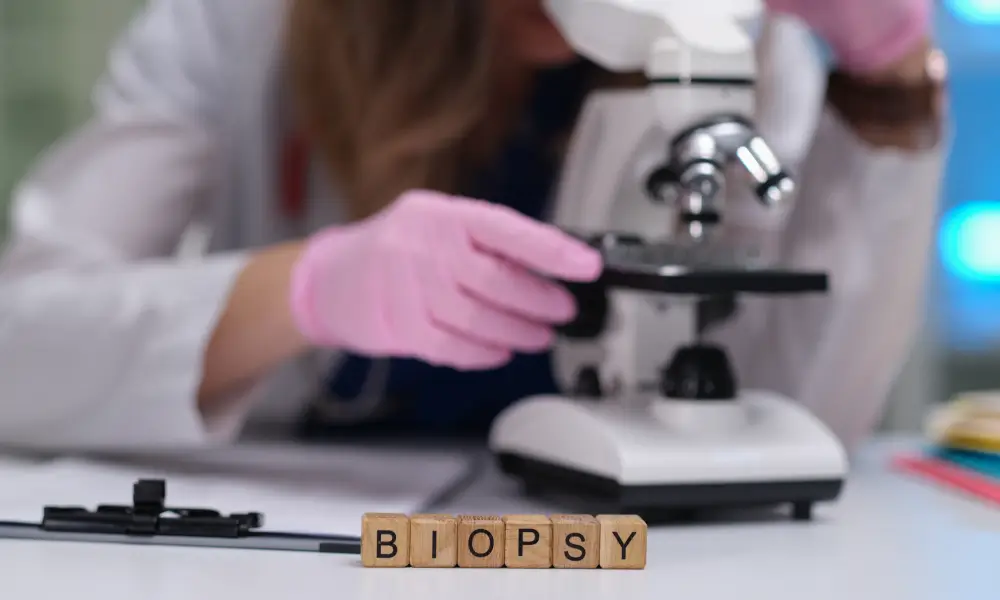Biopsy (Needle, Incisional, Excisional, Liquid) – Used for All Solid Tumours

TABLE OF CONTENTS
A biopsy provides significant information that helps doctors determine if cancer exists in a patient's body. This diagnostic procedure remains the only definitive way to make a proper diagnosis for most cancers. Doctors pick the best method based on the area they need to check, what condition they think it might be, and what kind of diagnosis they need.
This guide explores everything you need to know about biopsies – from different types and procedures to what happens after the test. You'll find clear explanations of how these tests help identify cancer and other conditions.
What Is a Biopsy?
A biopsy helps doctors take a small sample of tissue, cells, or fluid from a patient's body to test it in a lab. This medical procedure lets doctors check for many health conditions, not just cancer. Doctors often suggest this test when they spot something unusual during imaging tests or physical exams.
CT scans and MRIs can show abnormal tissue but can't tell if cells are cancerous or not. A biopsy provides the only definitive way to confirm a diagnosis. Most cancer diagnoses need this test to be accurate.
The process works in below mentioned manner:
Doctors remove tissue samples and preserve them in formaldehyde (or a similar fluid)
Staff label the container with the patient's details and sample location
Lab technicians look at the specimen with their eyes first, then under a microscope
The tissue goes through special staining to show up better
Biopsies help diagnose more than just cancer:
Inflammatory conditions like nephritis or hepatitis
Infections such as tuberculosis
Peptic ulcer disease
Endometriosis
Doctors can take samples from any body part where they suspect problems.
Types of Biopsy
Medical teams select biopsy methods that match the suspicious tissue's location and characteristics. Each technique plays a unique role in diagnosis.
Needle biopsy: Doctors perform needle biopsies by extracting tissue samples through the skin with specialised needles. A thin needle draws out fluid and cells during fine-needle aspiration which often yields same-day results.
Core needle biopsy: These procedures use a larger needle to remove a small cylinder of tissue, which allows a complete analysis.
Doctors can access internal areas through natural openings or small incisions with endoscopic procedures. They use flexible tubes equipped with cameras. The process includes bronchoscopy to examine the lungs, cystoscopy to check the bladder, and colonoscopy to inspect the colon.
Surgical biopsies: These procedures involve the removal of tissue through surgical methods. The doctor removes the entire suspicious area in excisional biopsies, while incisional biopsies take just a portion. These procedures need local anaesthesia, though deeper tissue examination might require general anaesthesia.
Skin biopsies: These include:
Shave biopsies where the doctor removes the top skin layers
Punch biopsies are the process involving extracting deeper cylindrical skin samples
Excisional biopsies involve removing the entire suspicious lesion.
Doctors extract bone marrow samples from hipbones to study blood cell formation.
Liquid biopsy: This new approach tests blood instead of tissue. This method detects circulating tumour cells, tumour DNA and exosomes. Patients benefit from this minimally invasive option (when traditional biopsies become challenging).
Indications
Your doctor might ask for this test after discovering suspicious areas during physical exams or imaging tests. Biopsies remain the only definitive way to diagnose most cancers. These tests can also identify:
Inflammatory disorders like nephritis (kidney) or hepatitis (liver)
Infections including tuberculosis
Immune disorders such as chronic pancreatitis
Endometriosis
Different body areas need different types of biopsies. Bone marrow biopsies help identify blood problems, both cancerous and non-cancerous. These tests can detect blood cancers like leukaemia, lymphoma, multiple myeloma, and cancers that have spread to bone marrow.
Specific biopsy applications include:
Breast, skin, liver, and lymph node examinations
Gastrointestinal tract, bladder, and colon assessments
Sentinel lymph node mapping for breast tumours or melanoma
Liquid biopsies examine blood instead of tissue to detect cancer markers like tumour cells or DNA. This method offers a less invasive option that proves valuable for monitoring treatment responses and detecting early-stage cancers.

Procedure and Techniques
Medical teams get tissue samples in different ways depending on the biopsy method. Healthcare teams prepare patients by positioning them correctly and cleaning their skin before starting the procedure.
During needle biopsies doctors push a thin needle through the skin into areas that look suspicious. A fine-needle aspiration uses a hollow needle to draw out fluid and cells, while a core needle biopsy needs a wider needle to remove cylinder-shaped tissue samples. These procedures can take anywhere from ten to sixty minutes based on how complex they are.
In surgical biopsies, surgeons take out either a portion (incisional) or the entire (excisional) suspicious tissue. Most procedures need local anaesthesia but deeper tissue removal might require general anaesthesia.
New technology helps doctors improve accuracy with imaging guidance:
Ultrasound
CT scans
MRI
Fluoroscopy
Liquid biopsies need just a simple blood draw. This method is less invasive and more comfortable than traditional approaches.
After collection, specialists preserve the samples in formaldehyde or other fluids and send them to labs. Lab technicians process these tissues with special staining methods to make them more visible under microscopes.
Most hospitals do biopsies as outpatient procedures, so patients can go home the same day with little recovery time.
Diagnostic Value
A biopsy's real strength comes from its diagnostic precision and reliability. When pathologists scrutinise these samples they can spot not just cancer's presence but also pinpoint its exact type.
Cancer detection through biopsies shows remarkable accuracy. Research indicates diagnostic accuracy rates between 85% and 99% (based on the method used).
Biopsies aren't perfect though. False results show up in about 1-2% of surgical pathology cases. Most misdiagnoses happen because of sampling errors or tissue contamination.
Complications
Biopsies play a vital role in diagnosis, but they come with risks that patients need to know about.
Pain, bleeding, and infection are the most common complications.
Pneumothorax (collapsed lung) remains the biggest risk in transthoracic needle biopsies. The risk is higher for patients with COPD.
Rare but serious complications need attention:
Air embolism
Nerve damage can lead to paraesthesia or neuropathic pain
Liquid biopsies might be less invasive, but they have their drawbacks. We faced economic hurdles and limitations in spotting early stage cancers.
Aftercare and Follow-up
Your recovery after a biopsy procedure depends heavily on proper aftercare. The time needed to recover varies with the type of biopsy and your health condition.
A fine-needle aspiration with local anaesthesia might leave you sore but you can usually get back to your normal routine the next day. You should avoid any hard physical work for at least two days after core needle biopsies. Surgical biopsies need more time - about a week before you can return to your usual activities.
Taking care of your biopsy site requires these essential steps:
Clean your hands really well before touching the area
Use mild soap and water to clean the site once or twice daily
Use petroleum jelly from a squeeze tube on the wound to keep it moist
Use a fresh bandage until the wound heals completely
You should get medical help right away if you have:
Fever
Pain that gets worse and won't respond to medicine
Skin changes around the biopsy site
Swelling that won't go away
Unusual drainage
Bleeding doesn't stop after 40 minutes of direct pressure.
Your doctor will schedule a follow-up meeting to discuss your results and next steps, usually within a week. Someone should come with you to this appointment - they can offer support and help you remember the key details.
Conclusion
Biopsies are still the best way to diagnose cancer and many other medical conditions accurately. Many people fear this procedure, but knowing what happens during the process helps reduce anxiety.
A doctor picks the best technique for each patient's case. The team's priority remains getting an accurate diagnosis while keeping the patient comfortable. Modern technology has made biopsies more precise through tools like ultrasound and CT scan guidance.
Clear answers about health concerns make biopsies invaluable for patients and doctors alike. Medical teams can quickly create the right treatment plans with this knowledge. The results might show cancer or another condition but this information equips both doctors and patients to take the right steps toward healing.
FAQs
What is a biopsy, and why is it performed for cancer diagnosis?
Many patients ask about biopsy procedures when they face possible cancer diagnoses. A biopsy takes tissue or cells from your body to look at them under a microscope. This test is the only sure way to diagnose most cancers, since CT scans and X-rays can't tell the difference between cancerous and non-cancerous cells. Your doctor might suggest this test if they spot something unusual during your physical exam or imaging tests.
What are the different types of biopsies?
Different biopsy methods are:
Needle biopsy: A needle draws out tissue or fluid, including fine-needle aspiration and core needle biopsies
Incisional biopsy: Takes out just a piece of the unusual area
Excisional biopsy: Removes the whole tumour or unusual area plus some healthy tissue around it
Liquid biopsy: Tests blood or other body fluids instead of tissue to find cancer cells or tumour DNA fragments
How is a needle biopsy different from an incisional or excisional biopsy?
Needle biopsies need only a thin or hollow needle that goes through your skin to get small tissue samples or fluids. These procedures are less invasive and need just local anaesthesia. Incisional and excisional biopsies are surgical procedures. Doctors remove part of a suspicious area in incisional biopsies, while they take out the entire unusual area plus some healthy tissue in excisional biopsies. Surgical biopsies usually need bigger cuts and sometimes general anaesthesia.
What cancers can be diagnosed using a biopsy?
Biopsies help doctors find many types of cancer. Common areas tested include:
Breast, skin and liver tumours
Lymph nodes to check for lymphoma
Bone marrow to find leukaemia, multiple myeloma and other blood cancers
Lung tissue to spot various lung cancers
Gastrointestinal tract, including the stomach and intestines
Doctors need to confirm almost all cancer types with a biopsy before starting treatment.
How is a liquid biopsy performed, and when is it preferred?
A liquid biopsy is a simple blood draw where doctors look at plasma for cancer cells or DNA. This simple test works best when:
Regular biopsies are too dangerous because of where the tumour sits
Doctors need to check progress during treatment
Patients can't have surgery
Traditional biopsies might miss something due to tumour variation
What are the risks or side effects associated with biopsy procedures?
Biopsies are generally safe with few risks. You might experience:
Pain or tenderness where the biopsy was done
Light bleeding and bruising
Swelling in the area
Infection (this rarely happens)
Serious problems are rare but could include heavy bleeding, collapsed lung (during chest biopsies), or allergic reactions to anaesthetics.
How accurate are biopsies in diagnosing cancers like ILC, TNBC, or HER2-positive breast cancer?
Different breast cancer types show varying accuracy rates. Ultrasound-guided biopsies achieve 92.2% accuracy in breast cancer detection. The precision rate for triple-negative breast cancer (TNBC) and HER2-positive tumour biopsies reaches 97.4%. Sensitivity rates tend to be lower for invasive lobular carcinoma (ILC) on ultrasound-guided biopsies.
How is biopsy tissue analysed to determine cancer subtype and treatment options?
Pathologists analyse tissue through several methods:
Hormone receptor testing (ER/PR) via immunohistochemistry
HER2 status assessment through FISH (Fluorescence In Situ Hybridisation)
Ki67 analysis to determine the proliferation rate
These markers help classify cancers into molecular subtypes—luminal A, luminal B, HER2-positive, or triple-negative—that directly shape treatment decisions.
How long does it take to get biopsy results?
Results usually come back within one to two weeks. Simple cases might yield results within hours, though complex ones need several weeks. Factors like tissue hardness, size, and specialised testing requirements can lead to delays.
Can a biopsy detect metastasis or only the primary tumour?
Biopsies can identify both primary tumours and metastatic disease effectively.





